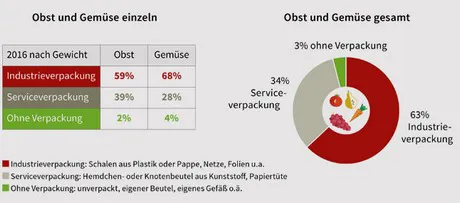Fruits and vegetables are sold more and more packaged in Germany. This is the result of a study commissioned by NABU. It is high time that the food trade rethinks and again offers more fruit and vegetables unpackaged.
In Germany, more and more packaging waste is accumulating. One reason for this is that more and more fresh fruit and vegetables are being sold pre-packaged - now at 63 percent. This is the result of a study by the GVM Gesellschaft für Verpackungsmarktforschung on behalf of NABU. For the first time in 2015, GVM updated the data collected on the packaging volume for fruit and vegetables.

Every year, more than 18 million tonnes of packaging waste accumulate in Germany (Federal Environmental Agency 2017) - and the trend is rising. Every German statistically produces 37 kg of plastic waste per year. One of the reasons for the increasing volume of packaging is that more and more fresh produce such as sausage, cheese and meat or fruit and vegetables is sold industrially pre-packed. Industrial packaging for fresh fruits and vegetables are, for example, trays with and without covers, nets or foils. In 2016, fresh vegetables consumed just under 34,000 tonnes of plastic and about 12,000 tonnes of paper, paperboard or cardboard (PPK), as well as more than 24,500 tonnes of plastic and more than 18,500 tonnes of PPK for fresh fruit.
The lion's share of fruit and vegetables now pre-packaged
Meanwhile, 59 percent of the fruit and 68 percent of the vegetables that private households buy in the supermarket or on the market are already pre-packed industrially. This means that customers do not have the option to dispense with a single-use packaging, for example by bringing their own bags along.
Plastic is the dominant packaging material
The study shows that plastic is the dominant packaging material, increasingly replacing paper, board or cardboard packaging. The plastic requirements for pre-packaging increased by 94 percent between 2000 and 2016 and by as much as 186 percent in the case of vegetables. It should also be taken into account that plastic is a very light packing material compared to paper and cardboard.
Vegetables: Largest packaging share for tomatoes
Tomatoes account for the largest share of fresh vegetable packaging, accounting for 30 percent. At the same time, however, they account for only 15% of household consumption. This shows that tomatoes are very packaging-intensive, especially with small pack sizes and material-intensive tray packaging.
Plastic waste: Great savings potential in the supermarket
In total, more than 93,000 tonnes of packaging waste came together in 2016, although in the opinion of the NABU fruit and vegetables usually do not require pre-packaging. A larger proportion of loose goods could save a significant proportion of this packaging waste. The consumption of packaging for industrial packaging is many times higher than for service packaging, ie paper bags or knot bags made of plastic. And even the latter are not really a solution either, since in the medium term, the goal must be to reduce these too.
NABU is therefore calling for retailers to offer fruit and vegetables unpackaged more often and to give customers the option of using their own reusable bags instead of plastic or paper disposable bags. According to a survey by the NABU, 85 percent would be prepared to avoid plastic waste.
Source: NABU 2019
